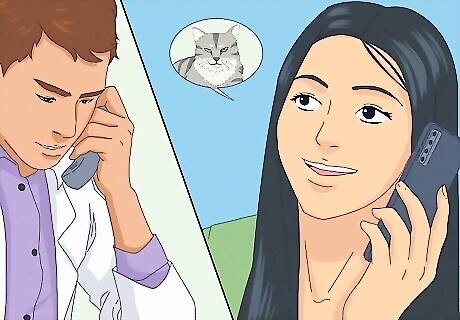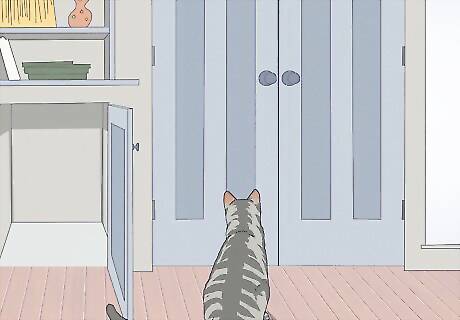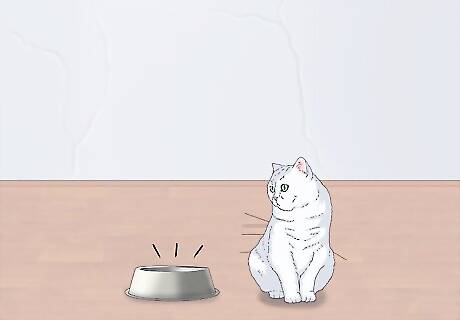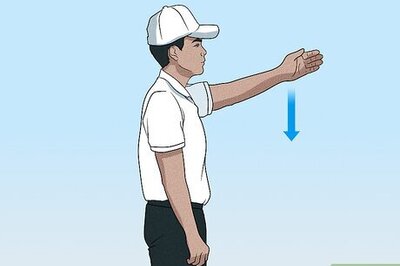
views
X
Trustworthy Source
American Society for the Prevention of Cruelty to Animals
Leading organization dedicated to the prevention of animal cruelty
Go to source
It shrinks feral cat colonies over time, as well as cutting down on the fighting and vocalizing that can occur in these colonies. If you're a pet owner yourself, or just a conscientious animal lover, you may want to help get your neighborhood strays spayed or neutered. Trapping feral cats to get them fixed is an important service to your community and the animals that live there.
Attracting a Feral Cat

Establishing a regular feeding routine. If your property has a lot of feral cats around and you want to get them spayed or neutered, you can start a regular and controlled feeding routine. Put food out at the same time and place daily. Food is usually the easiest way to get feral cats to come into your vicinity.

Let the cat get used to your presence. Don't try to grab the cat, or even touch the cat, as most feral cats are extremely skittish and loathe to be touched by humans. Instead, stay outside and sit quietly in a chair nearby after putting out the food. Stay extremely still and remain quiet while the cat feeds. Let the cat control the situation. If it comes over to you and rubs against you, great. If not, just sit there are be quiet. It's still getting used to being around you.
Preparing to Trap a Feral Cat

Obtain a live trap. The safest way to trap a feral cat, or a wild animal of any kind, is to use a safe live trap, such as the Havahart brand. A medium-sized trap should be fine for most feral cats and raccoon-sized animals. Most brands of live trap work essentially the same way, but follow the instructions particular to the model you get. A live trap has openings at both ends and a basic trigger in the center on which to put food. When the cat enters the cage and triggers the trap, the doors shut, enclosing the cat inside the cage. It's easy to transport and comfortable for the cat. In some cities, spay and neuter organizations will provide live traps to borrow for people hoping to bring cats in. Research your options locally if you don't want to buy one yourself.

Make an appointment to get the animal spayed or neutered. Set up the appointment a few days before you try to trap the cat to give the animal time to get used to the trap and give yourself enough opportunities to catch the animal. Make sure that the vet will use dissolving stitches, so that the cat will not need a return visit before you release it back to the colony. Let the veterinarian know anything you know about the cat, such as its sex, any health issues you might've noticed, and whether or not you have any idea about the cat's age.

Feed the cat in the trap for a few days before the appointment. Gradually move the food you are feeding the feral cat into the trap. You can open the doors of most live traps without setting them, allowing an animal to pass freely in and out of the trap without actually trapping it. You might consider setting out the food at the regular time to let the animal get used to the cage and let it get some of its scent and pheromones in the space to make it more comfortable.
Setting a Trap

Prepare your holding area before setting the trap. You will need a quiet, protected spot to keep the trapped cat before the clinic appointment and after the surgery. It should be a place where the temperature is mild (anesthesia renders them with less ability to regulate their body temperature), protects them from other animals. Make sure it is also quiet and free of disturbance. A spare bedroom or any dark area of your house would be appropriate. Closets or finished basements would also do nicely.

Withhold food for 12 hours before the appointment. To make sure the cat will be enthusiastic for the food you put out in the trap, as well as not overfed before undergoing surgery, skip a feeding. It might be hard, but resist the urge to put food out before you're ready to trap the cat. While you can withhold food, don't withhold water! Be sure to continue to give the feral cat water even the night before the attempted trapping.

Set the trap. At the appropriate feeding-time (ideally 12-24 hours before the appointment), fold a lightweight cloth lengthwise and insert it to cover the wire bottom of the trap and the trip plate. Put about 2 tablespoons (30 ml) of canned cat food (or tuna, mackerel, or some other strong-smelling enticing food) at the very back of the trap. Set the trap and put it on a flat surface where it won't shift or tip prematurely. You can drizzle some juice or oil from the food in a zigzag pattern from the back of the trap towards the front if you want some extra attraction. Alternately, sprinkle a few grains of dry food leading into the back of the trap, but not too much. Consider putting an empty lid or cup in the cage to fill later with water after the cat's been trapped. Make sure the container doesn't have any sharp edges that the cat could get cut on. You can use a turkey baster to fill the lit from a comfortable distance.

Wait and watch. Don't leave the trap unattended but you don't have to spring into action immediately after the cat is trapped. It can, however, calm the cat down considerably to cover the trap immediately with a blanket or tarp after you see the trap has sprung effectively. Either way, bring the trap inside to your holding area as soon as you notice the cat's been trapped inside. It might thrash considerably, so be careful to keep your fingers out of the openings. The cat may whine and make otherwise terrible sounds that can be heartbreaking. Remember: You're doing the right thing.
Getting a Feral Cat Spayed or Neutered

Keep the trap covered at all times. Let the cat relax and calm down in your holding area until the appointment. Let it have some water and try to keep the environment as calm and quiet as possible.

Get your car ready. You might put a tarp or blanket down on your backseat, just in case the cat decides to urinate or spray in your car while being transported. Remember, this is an extraordinarily weird experience for the cat, so be prepared for it to act out.

Carry the cat slowly and gently. When it's time for the appointment, carry the cat very gently and slowly, making smooth movements and keeping your hands far from the openings and gaps in the cage. Drive the cat to the appointment and let the vets take control of the situation. Make sure the veterinary office knows the cat is feral. Speak gently to the cat in a soothing voice and keep the situation calm. Don't play loud music or drive with the windows down.

Follow the post-surgery instructions for feral cats until time to release the cat. Your vet will advise you on the basic procedures, and you'll be able to keep the cat for a few hours overnight in your holding area before releasing it or taking it where you wish.

Discuss relocation options with a local shelter or ASPCA. Generally speaking, it is not advisable to relocate cats unless there is no other choice, or the regular habitat is in some way dangerous for the animal. If this is something that must be done, contact your local animal shelter for tips on other options, or research no-kill shelters in your area if it comes to that.

















Comments
0 comment